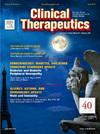Dosing of Venetoclax in Pediatric Patients with Relapsed Acute Myeloid Leukemia: Analysis of Developmental Pharmacokinetics and Exposure-Response Relationships
IF 3.2
4区 医学
Q2 PHARMACOLOGY & PHARMACY
引用次数: 0
Abstract
Purpose
This work aimed to characterize the pharmacokinetics and exposure-response relationships of venetoclax in pediatric patients with relapsed or refractory (R/R) acute myeloid leukemia (AML) to identify venetoclax doses to be administered to pediatric patients in the phase 3 study.
Methods
Data from 121 patients across three phase 1 studies enrolling pediatric patients with R/R malignancies were utilized to develop a population pharmacokinetic model to describe venetoclax pharmacokinetics in pediatric patients. Individual patient average venetoclax plasma concentration up to the event of interest, derived based on the population pharmacokinetics analysis, was used to evaluate the exposure-response relationships to efficacy (complete response) and safety (neutropenia and thrombocytopenia) endpoints for patients with AML who received venetoclax in combination with azacitidine, decitabine, or cytarabine (n = 36). The population pharmacokinetic model was then used to simulate exposures in pediatric age- and weight-based subgroups to identify the venetoclax doses for pediatric patients.
Findings
The pharmacokinetic data were adequately described by the two-compartment population pharmacokinetic model with first-order absorption and elimination. The model accounted for cytochrome P450 3A developmental changes using a maturation function and incorporated allometric scaling to account for growth and body size effect. Weight was identified as a statistically significant covariate on clearance and volume of distribution and retained in the final model. Population pharmacokinetic estimates were comparable to previously reported estimates in adults. Exposure-response analyses suggested that the clinical efficacy of venetoclax in combination with high-dose cytarabine (HDAC) is maximized at 600 mg adult-equivalent, and higher doses are unlikely to enhance clinical efficacy. Venetoclax 600 mg adult-equivalent was selected for further development in combination with HDAC. Additionally, venetoclax 400 mg adult-equivalent was selected for bridging/maintenance therapy in combination with azacitidine. Flat exposure-response relationships were observed with Grade ≥3 neutropenia and thrombocytopenia. Doses were selected based on weight (allometric scaling) for children aged ≥2 years old and based on weight and CYP3A ontogeny for children aged <2 years. The selected age- and weight-based dosing scheme of venetoclax is projected to achieve venetoclax exposures in pediatric subgroups comparable to those observed in adults receiving venetoclax 400 mg or 600 mg.
Implications
This work characterized the pharmacokinetics and exposure-response relationships of venetoclax in pediatric patients and guided the selection of pediatric dosing regimens in support of the venetoclax phase 3 trial in pediatric AML (NCT05183035).
Clinical Studies
NCT03236857, NCT03181126, and NCT03194932.
复发性急性髓性白血病儿科患者的 Venetoclax 剂量:发育药代动力学和暴露-反应关系分析
目的:本研究旨在描述venetoclax在复发或难治性(R/R)急性髓性白血病(AML)儿科患者中的药代动力学和暴露-反应关系,以确定3期研究中儿科患者的venetoclax给药剂量:方法:利用三项一期研究中121例R/R恶性肿瘤儿科患者的数据,建立了一个群体药代动力学模型,以描述儿科患者的venetoclax药代动力学。根据群体药代动力学分析得出的截至相关事件发生时的单个患者平均 Venetoclax 血浆浓度,用于评估接受 Venetoclax 与阿扎胞苷、地西他滨或阿糖胞苷联合治疗的急性髓细胞性白血病患者(n = 36)的疗效(完全应答)和安全性(中性粒细胞减少和血小板减少)终点的暴露-反应关系。然后使用群体药代动力学模型模拟儿科年龄和体重亚组的暴露量,以确定儿科患者的 Venetoclax 剂量:研究结果:采用一阶吸收和消除的两室群体药代动力学模型充分描述了药代动力学数据。该模型使用成熟函数考虑了细胞色素 P450 3A 的发育变化,并纳入了异速缩放以考虑生长和体型效应。体重被确定为对清除率和分布容积有统计学意义的协变量,并保留在最终模型中。人群药代动力学估计值与之前报道的成人估计值相当。暴露-反应分析表明,Venetoclax与大剂量阿糖胞苷(HDAC)联用的临床疗效在600毫克成人当量时达到最大,更大剂量不太可能提高临床疗效。Venetoclax 600 毫克成人当量被选作与 HDAC 联用的进一步开发剂量。此外,Venetoclax 400 毫克成人当量被选为与阿扎胞苷联用的桥接/维持疗法。在≥3级中性粒细胞减少症和血小板减少症中观察到平缓的暴露-反应关系。对于年龄≥2岁的儿童,剂量的选择基于体重(异构比例);对于年龄小于2岁的儿童,剂量的选择基于体重和CYP3A的发育:这项工作描述了venetoclax在儿童患者中的药代动力学和暴露-反应关系,并指导了儿童给药方案的选择,以支持venetoclax在儿童急性髓细胞白血病中的3期试验(NCT05183035):临床研究:NCT03236857、NCT03181126 和 NCT03194932。
本文章由计算机程序翻译,如有差异,请以英文原文为准。
求助全文
约1分钟内获得全文
求助全文
来源期刊

Clinical therapeutics
医学-药学
CiteScore
6.00
自引率
3.10%
发文量
154
审稿时长
9 weeks
期刊介绍:
Clinical Therapeutics provides peer-reviewed, rapid publication of recent developments in drug and other therapies as well as in diagnostics, pharmacoeconomics, health policy, treatment outcomes, and innovations in drug and biologics research. In addition Clinical Therapeutics features updates on specific topics collated by expert Topic Editors. Clinical Therapeutics is read by a large international audience of scientists and clinicians in a variety of research, academic, and clinical practice settings. Articles are indexed by all major biomedical abstracting databases.
 求助内容:
求助内容: 应助结果提醒方式:
应助结果提醒方式:


